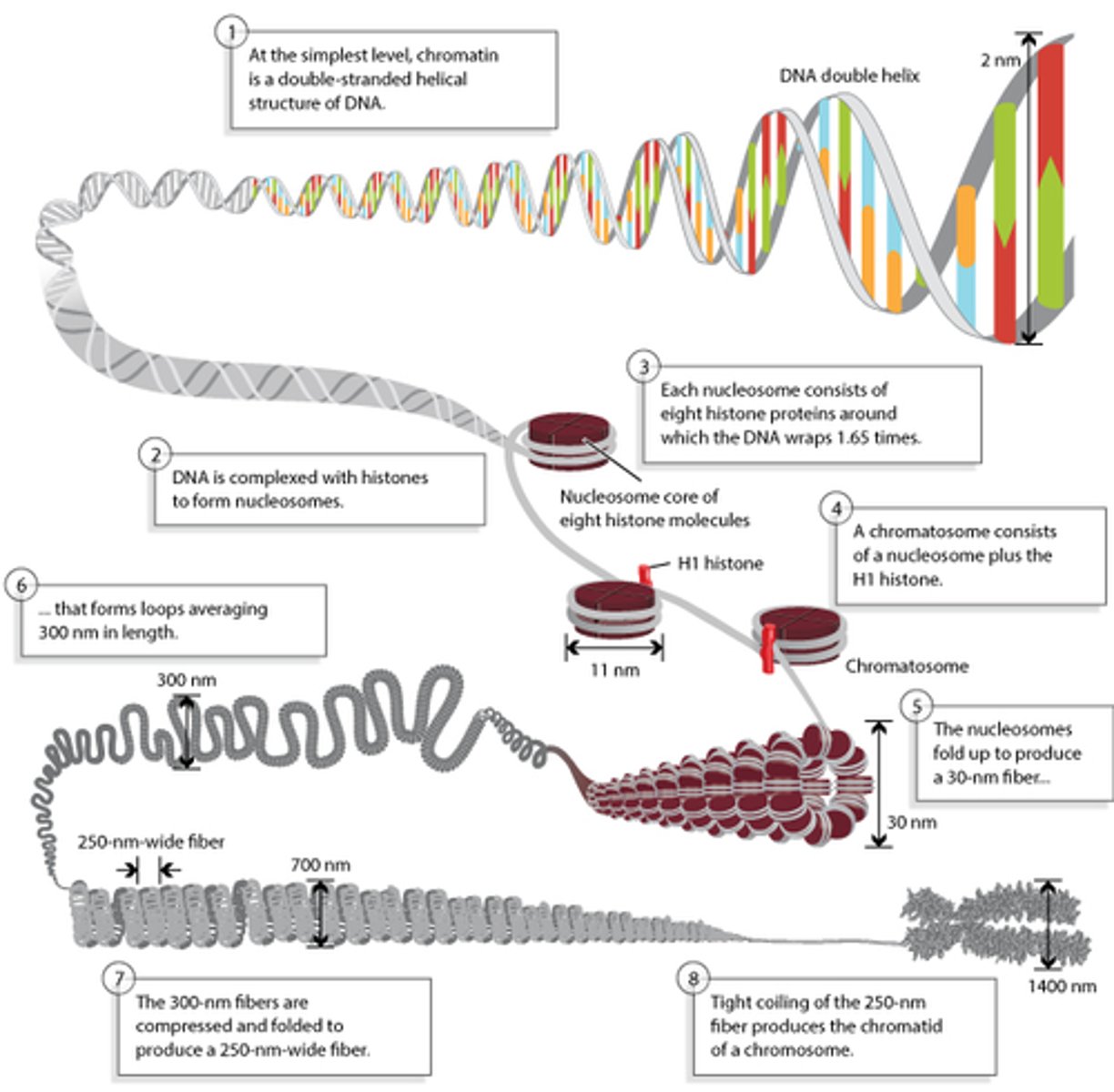PHAR520 - Eukaryotic Gene Organization
1/70
There's no tags or description
Looks like no tags are added yet.
Name | Mastery | Learn | Test | Matching | Spaced |
|---|
No study sessions yet.
71 Terms
What pathway involves the modification of chemical structures of small molecules by enzymes?
Metabolic pathways
What pathway involves the maintenance and expression of genetic information stored as a nucleotide sequence?
Information pathways
Describe the central dogma of molecular biology.
Information is transferred in a single, non-reversible direction of DNA to RNA through transcription, and RNA to protein through translation.

Information from parental DNA is copied to _______________ with high fidelity via _______________.
Information from parental DNA is copied to daughter DNA with high fidelity via DNA replication.
RNA is synthesized using _______________ as a template during _______________.
RNA is synthesized using DNA as a template during transcription.
Proteins are synthesized based on information stored in _______________.
Proteins are synthesized based on information stored in ribonucleotide triplets.
What/"who" is the caveat to the central dogma?
Viruses
Able to make RNA and DNA using RNA as a template (instead of DNA) in reverse transcription.
Give the current definition of a gene.
A segment of DNA that codes for a peptide and RNA, with the ability to express differently to yield different products (genetic variation).
When it was said that a gene was responsible for a characteristic what did it refer to?
Phenotype
How is DNA in a virion or cell organized in order to contain the very large size of the macromolecule?
In compact forms, typically via coiling and association with proteins
The protein's _______________ determines its biological function.
The protein's sequence determines its biological function.
In _______________, one strand of double-stranded DNA acts as the molecular template for RNA synthesis.
Transcription
In _______________, the triplets of nucleotides in mRNA bind to complementary triplets in tRNA.
Translation
tRNA contain what that are associated with a particular triplet that is used to be assembled into peptides?
Amino acids
How is eukaryote DNA organized?
Multiple discrete chromosomes, composed of two sister chromatids joined by a centromere.
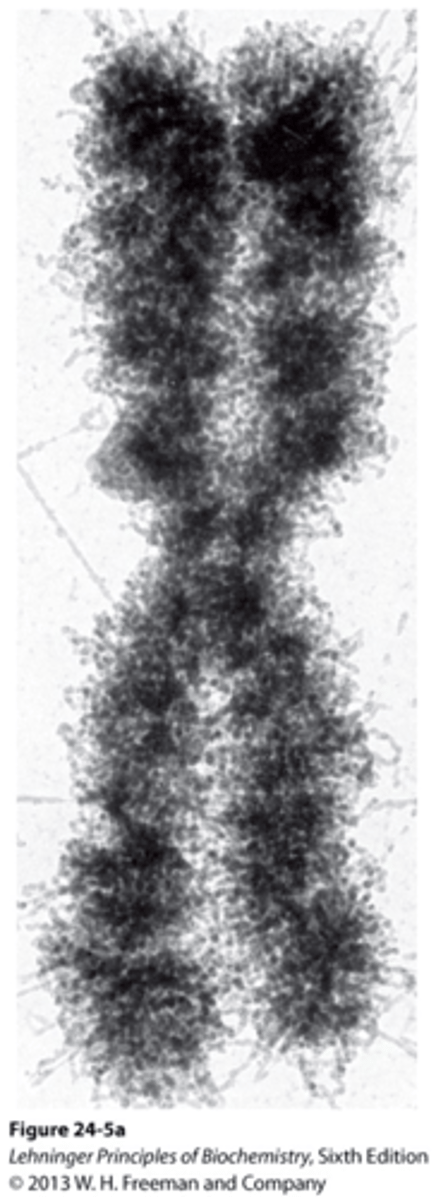
How many chromosomes do human somatic (non-sex) cells have?
46 (22 pairs (diploid), plus X and Y)
- Human mitochondrial DNA (mtDNA)
- Plant mtDNA
- Chloroplast DNA
Double-stranded circles
• Human mitochondrial DNA (mtDNA)
- 16,569 bp
- 2 - 10 mtDNAs per mitochondrion
• Plant mtDNA
- 200,000
- 2,500,000 bp
• Chloroplast DNA
- 120,000
- 160,000 bp
What are not indicators of the complexity of an organism?
Total length of DNA or the total number of chromosomes
EX: Dogs and coyotes have 78 chromosomes; amphibians have a much longer length of DNA; plants have more total genes
Most of eukaryotic DNA is...
Non-coding
What percentage of the total human genome encodes for proteins?
1.5% (small)
The complex that eukaryotic DNA is organized into with proteins is called...
Chromatin
What are viral and prokaryotic DNA associated with?
Viral - Associated with capsid proteins
Prokaryotic - Associated with proteins in the nucloid
List three of the theories of the composition of the human gene.
i. Some DNA regions participate in regulation of gene expression
ii. Some DNA encodes for small regulatory RNA
iii. Some DNA is remnant of viral infections or "junk"
Define an exon.
Amino acid sequences that are translated and expressed as proteins.
Define an intron.
Regions of genes that are transcribed into RNA, but not translated into protein.
What is the main difference between introns and exons?
Introns are removed after transcription as the RNA matures.
Exon mRNA sequences are spliced together and highly conserved.
Once both of these has occurred, it create a "mature transcript".

Sequences of genes known as what are able to move around within the genome of a single cell?
Transposons
What do the end of transposons contain?
Terminal repeats
Transposons account for how much of the human genome?
50%
Describe the activity of transposons.
Repeats hybridize with complementary regions of target DNA during insertion.
Short sequences ( ≤ 10) of base pairs repeated millions of times are known as what?
Simple sequence repeats (SSRs) or "satellite" DNA
Why are simple sequence repeats (SSRs) also known as "satellite" DNA?
Once these protein sequences are fragmented and centrifuged, it separates into discrete "satellite" bands.
What cap the ends of eukaryotic chromosomes?
Telomere
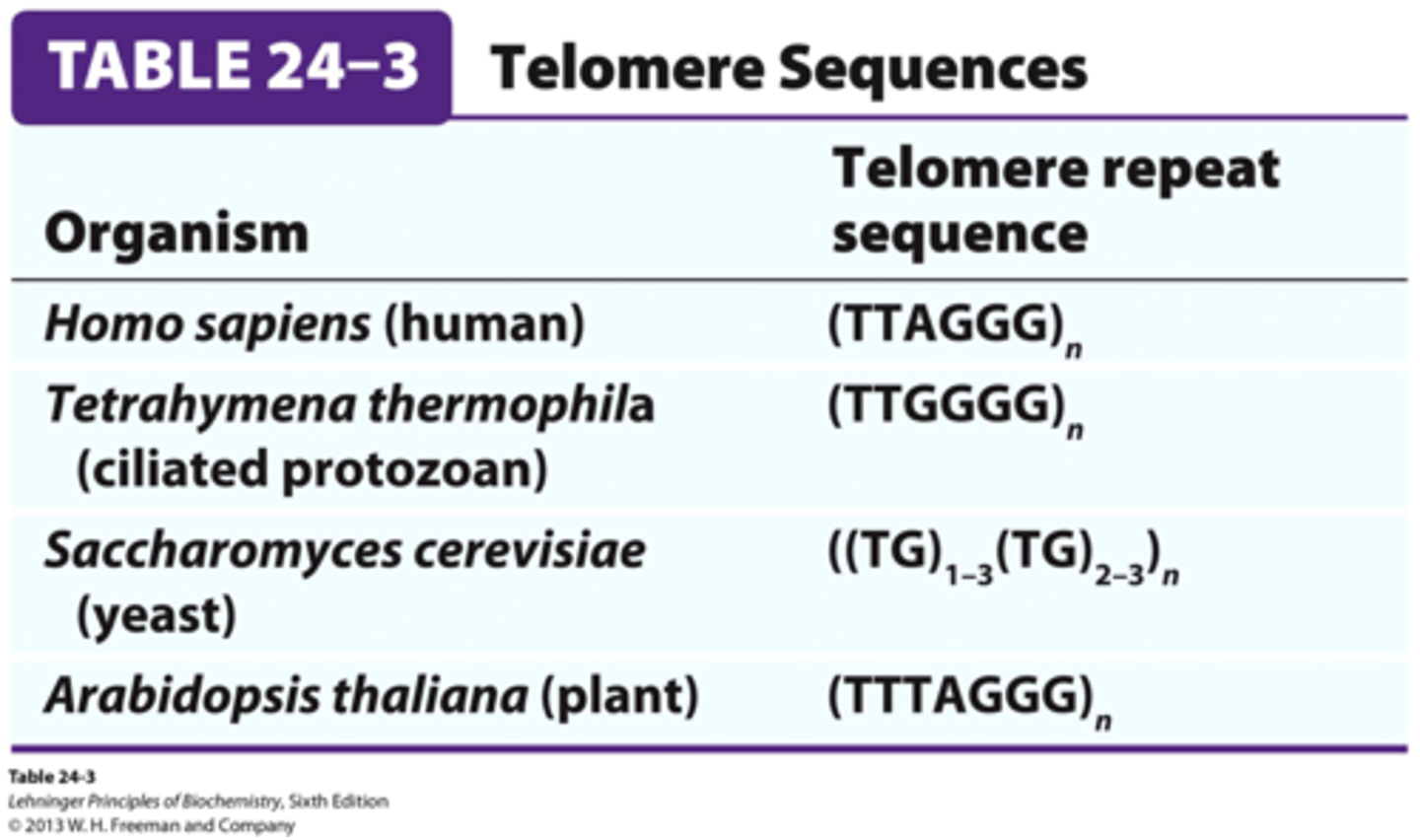
What is the supposed action of telomeres?
Cap the end of eukaryotic chromosomes by creating a special loop structure that prevents DNA from unraveling.
What enzyme adds and maintains telomeres?
Telomerase
When is cellular DNA considered to be "aging"?
After each round of replication as telomeres are shortened.
Define and give the Hayflick limit.
Normal human cells divide about 52 times before losing the ability to divide again.
Where do proteins attach during mitosis?
Centromere sequences
What holds the two daughter chromosomes together during mitosis?
Centromere
What is the importance of the centromere in cell division?
Essential for equal distribution of chromosome sets to daughter cells.

Why is DNA supercoiling important?
It allows the packing of a large amount of DNA molecules within a cells while still allowing access to proteins to read the information in DNA sequence.
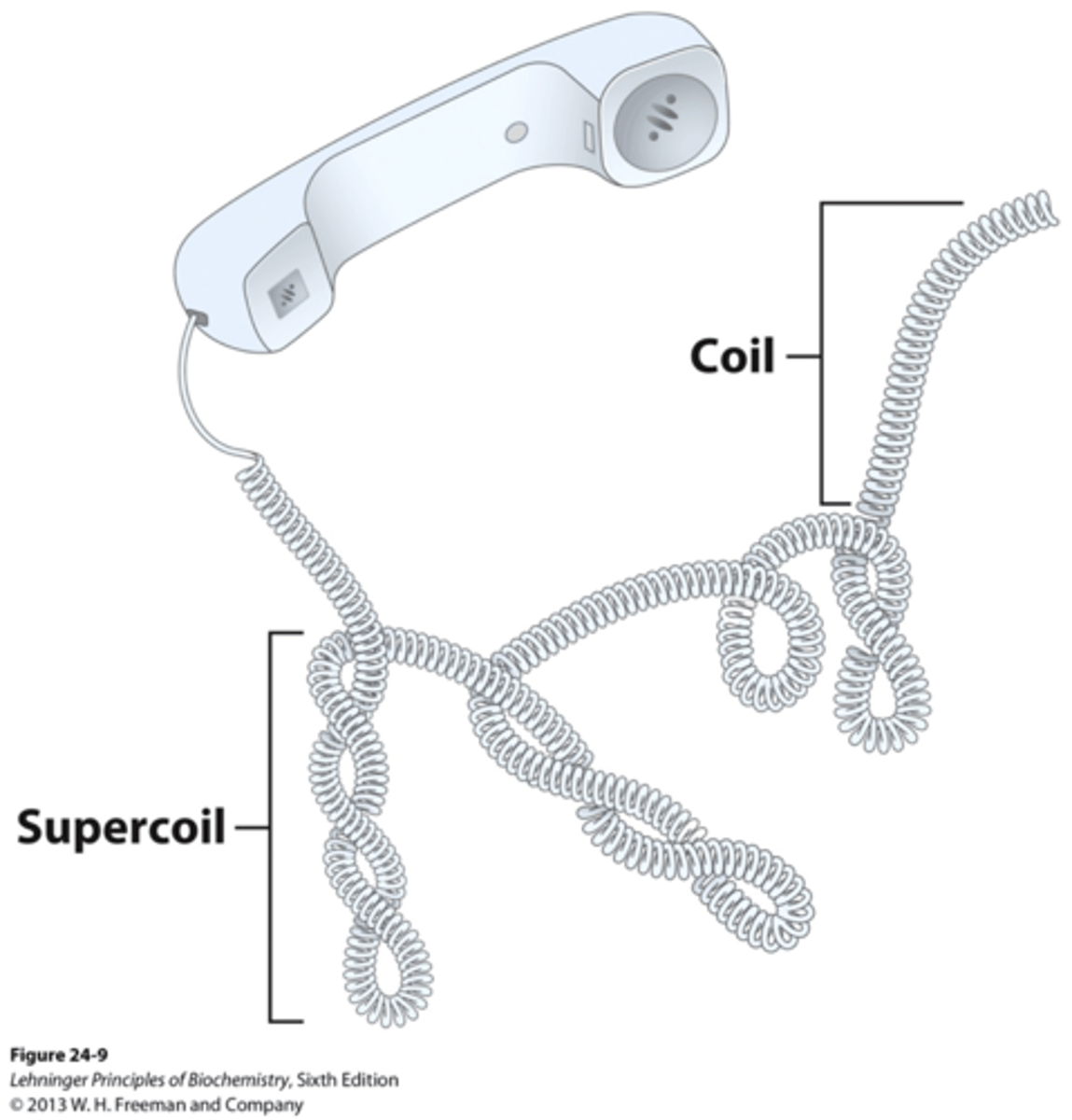
Non-supercoiled DNA is called...
Relaxed
What are the effect of replication and transcription on DNA supercoiling?
The progress of the DNA or RNA polymerase along the parent DNA strand can cause underwound or overwound DNA to occur downstream and upstream of it.
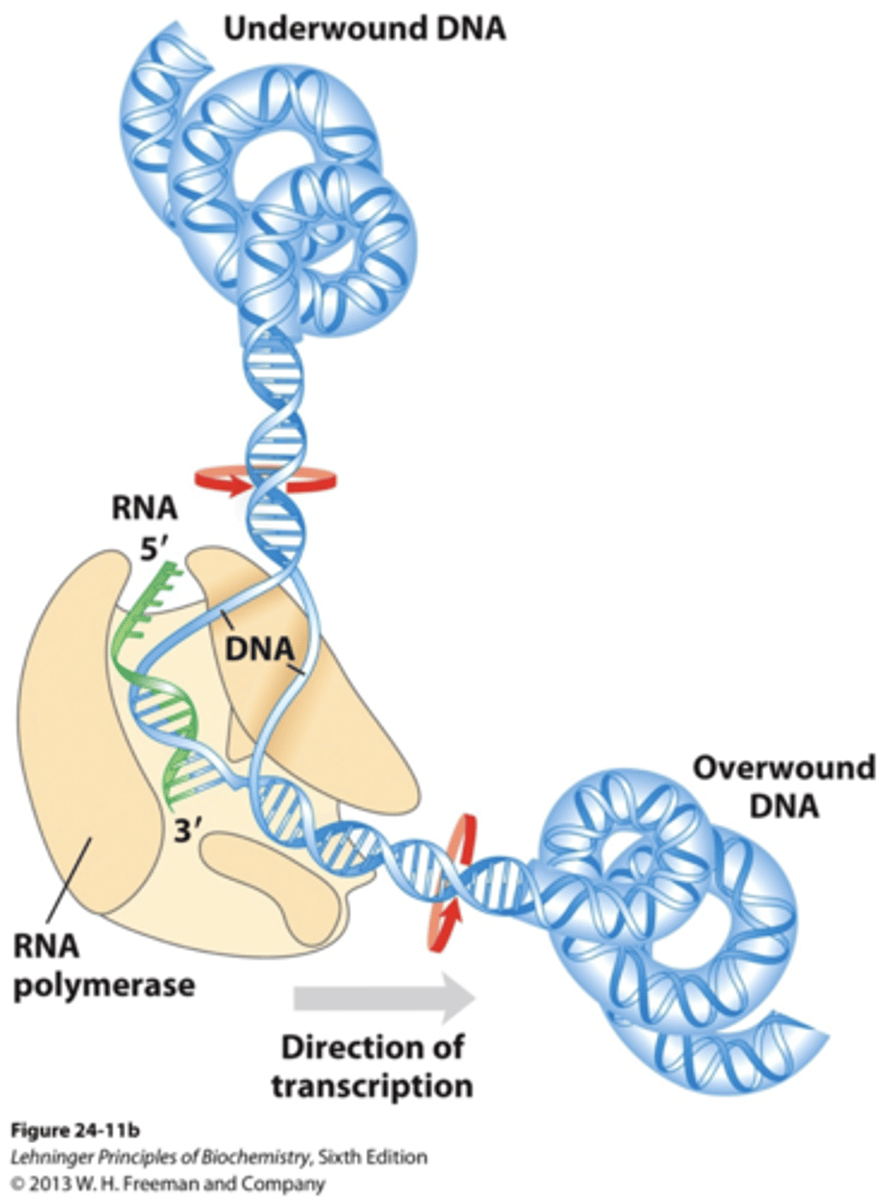
Most cellular DNA is (underwound/overwound).
Underwound
Linear DNA is underwound with the help of..
Proteins that prevent strands from rotating ("locking")
What induces closed circular DNA to be supercoiled?
Strain
What makes later separation of strands easier?
Underwinding
Which helps to facilitate additional DNA structural changes and maintenance of cruciforms at palindromes - overwound or underwound?
Underwound
Being more relaxed facilitates formation of strengths of left-handed Z-forms.
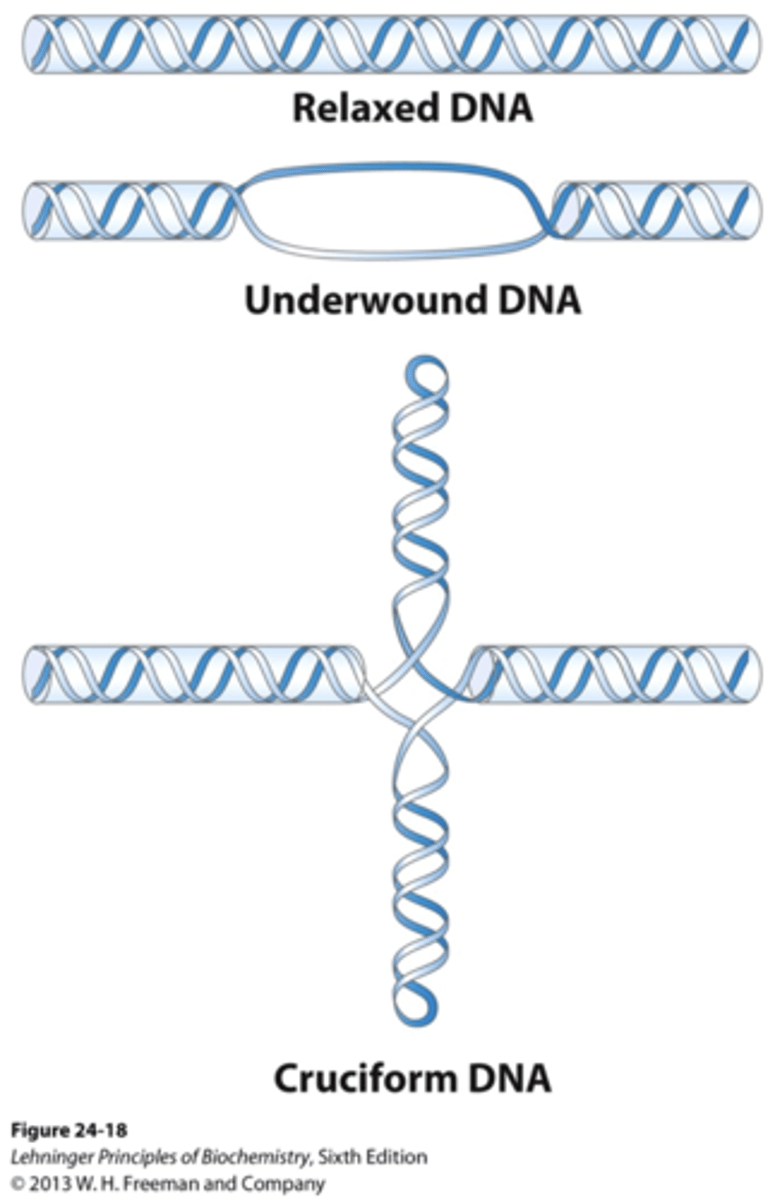
What are topoisomers?
DNA structures that differ only in conformation (linking number), an have the same number of base pairs and same sequence.
What is required for the conversion between toposiomers?
DNA strand break
What type of supercoiled DNA travels faster in agarose gel electrophoresis than relaxed or nicked DNA?
Negatively supercoiled DNA
What is the main function of topoisomerases?
Unwinding and rewinding DNA during transcription and replication.
List the two major types of topoisomerases and the difference between the two.
Type I - Makes a cut in ONE strand of DNA
Type II - Makes a cut in TWO strands of DNA
Describe the mechanism of action for the Type I topoisomerases.
i. Tyr reside attacks the phosphate and cuts one strand of DNA
ii. Unbroken strand passes through the break in DNA
iii. Phosphate attacks Tyr-Phos bond
iv. DNA bond is restored
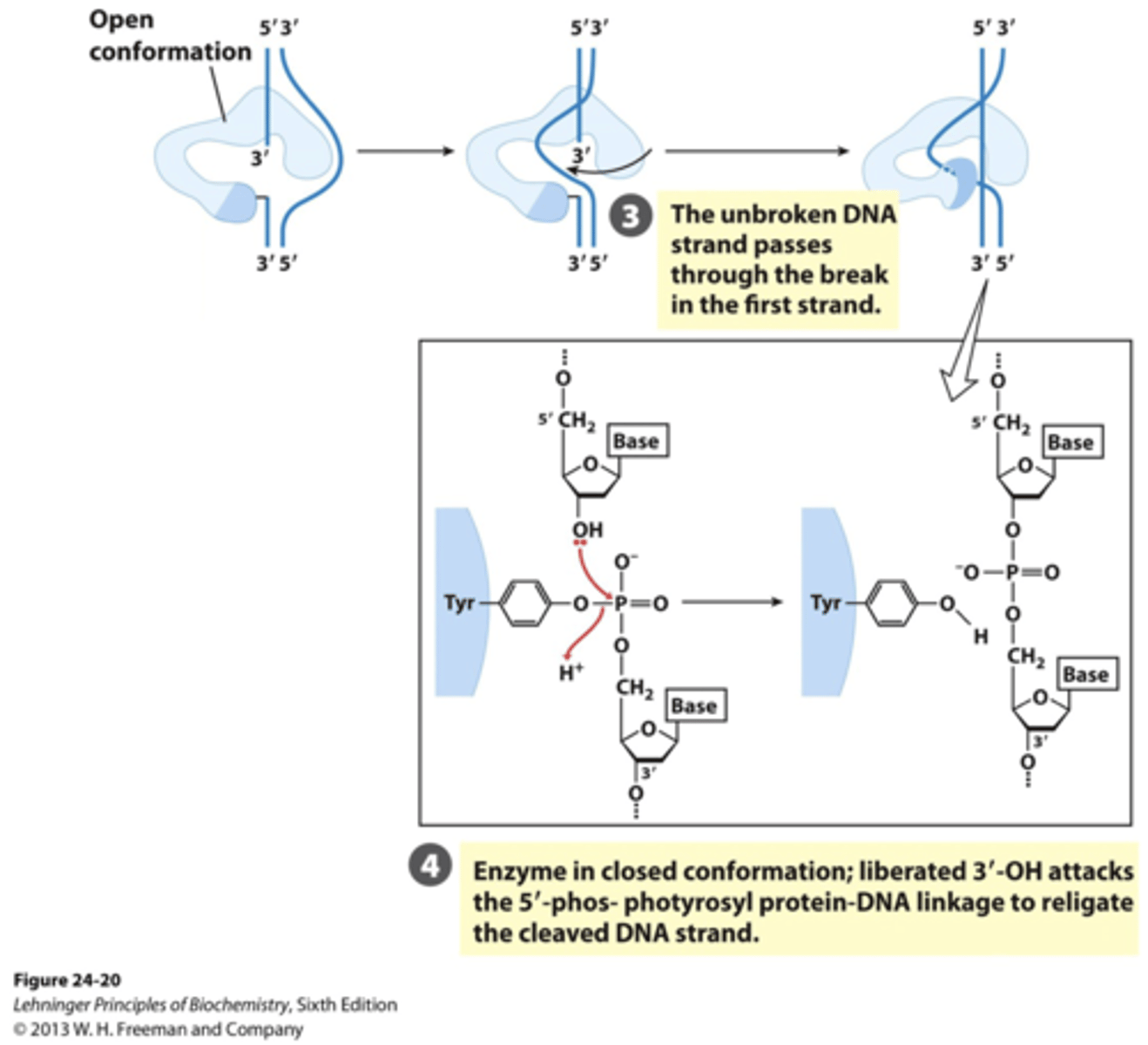
List the major types of eukaryotic topoisomerases that Dr. Nybo wants us to remember.
i. Topo I
ii. Topo II⍺
iii. Topo IIβ
iv. Topo III
v. Topo IV
* Continue with Slide 48 *
Describe the mechanism of action for the Type II⍺ topoisomerase.
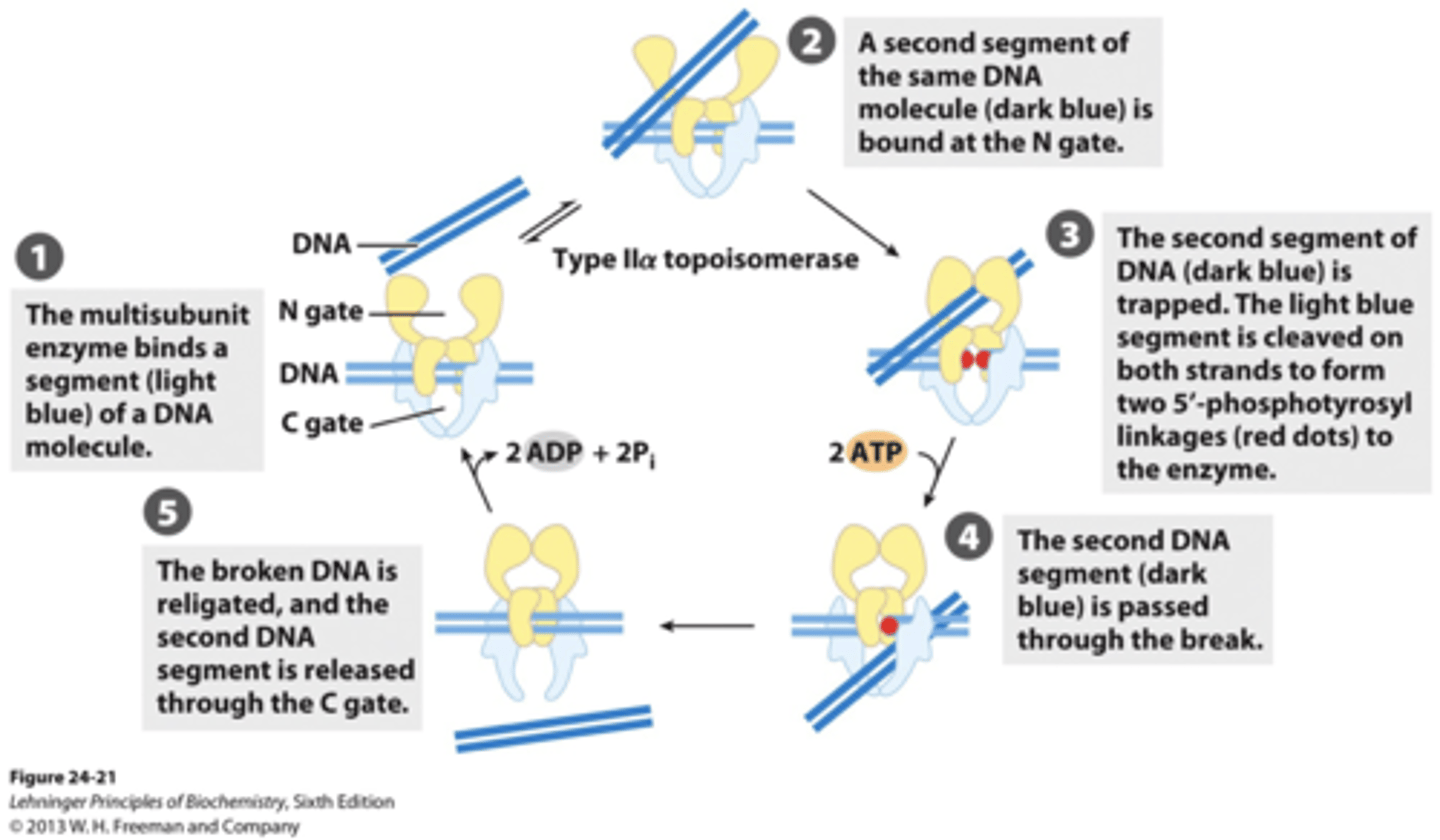
Topoisomerases are targets for what class of drug?
Antibiotics
Give an example of a medication that acts by inhibits bacterial type II topoisomerase from binding to ATP to prevent the replication of bacterial DNA.
Coumarins
- Nobobiocin
- Coumermycin A1
What class of medication inhibits the last step, the resealing step of DNA breaks, in DNA replication by topoisomerases?
Quinolones (e.g., ciprofloxacin, Cipro)
List some eukaryotic Type I topoisomerase inhibitors.
- Capotothecin
- Irinotecan (Campto)
- Topotecan (Hycamtin)
List some eukaryotic Type II topoisomerase inhibitors.
- Doxorubicin (Adriamycin)
- Etoposide (Etophophos)
- Ellepticine
What composes chromatin?
Fibers of DNA and proteins
What are histones?
Proteins that tightly associate with DNA (often the proteins seen in chromatin) that help to package the information in DNA.
Histones often have what type of charge - positive or negative?
Positive
What are the discrete units that DNA and protein are packaged into before chromatin?
Nucleosomes
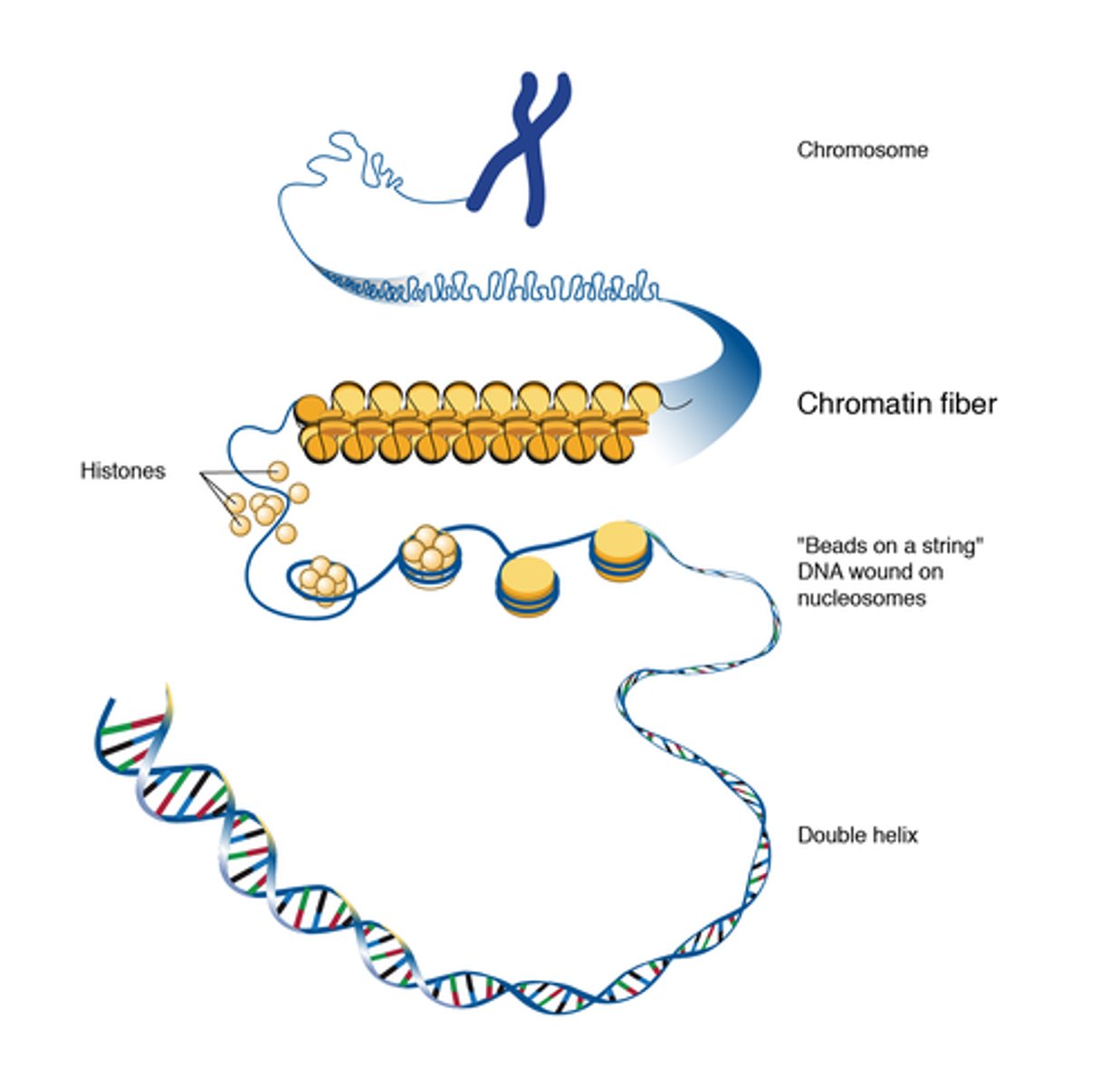
Nucleosomal DNA wrapped around a histone core is...
Underwound
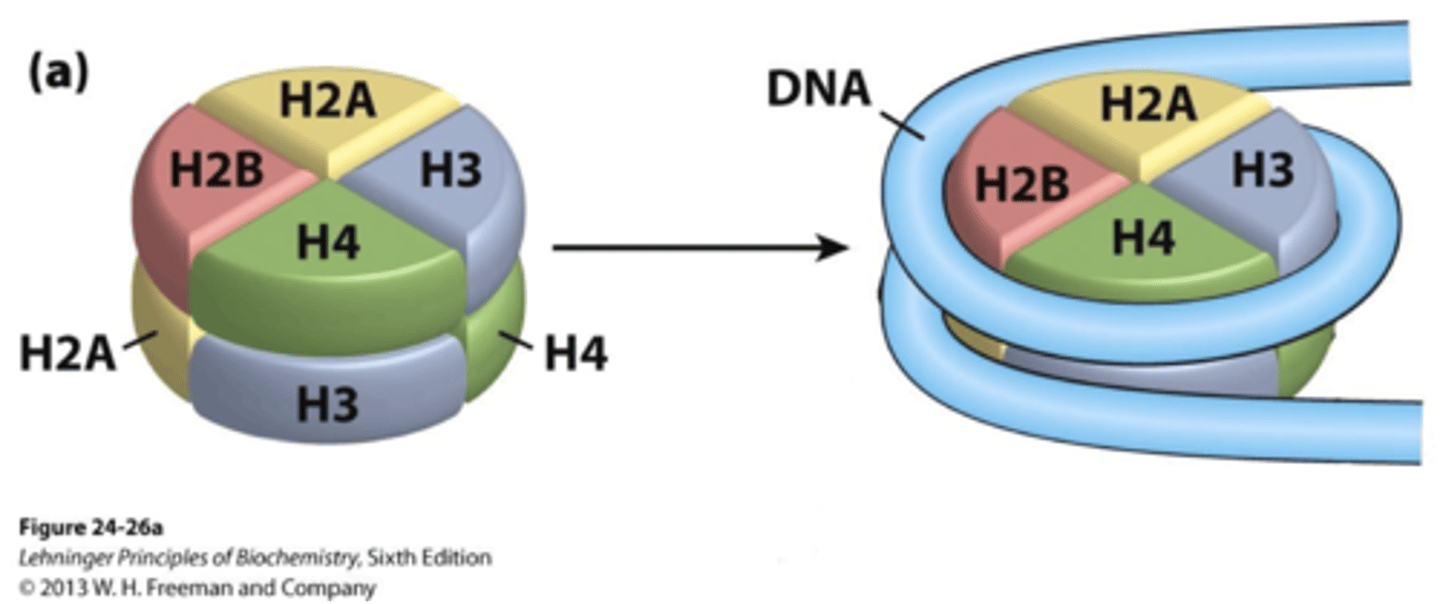
What helps to define higher-order DNA packaging?
Organization of DNA wrapped around histones aligns amino-terminal tails from one nucleosome to another, helping to form and strengthen a connection.
Histone binding depends on what?
DNA sequence
Histone binding more often occurs where?
A-T rich regions
List the stages, from smallest to largest, of DNA compaction in eukaryotic chromosomes.
i. DNA
ii. Nucleosome (DNA + histone)
iii. DNA fiber (Nucleosomes supercoil)
iv. Chromatic
v. Chromosome
